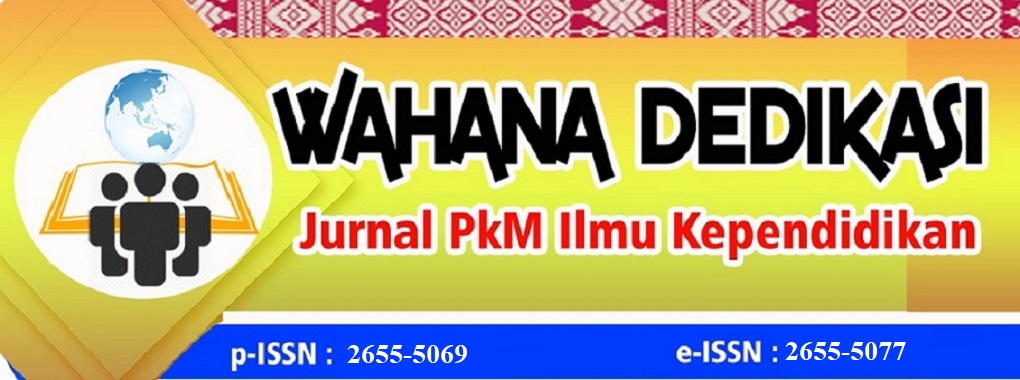Penyuluhan Tentang Bahaya Perundungan Melalui Pendekatan Olahraga Permainan di Sekolah Dasar
DOI:
https://doi.org/10.31851/dedikasi.v7i1.15491Abstract
The problem of bullying is a fairly complex problem for students that must be anticipated by parents and educators. The rampant acts of bullying result in physical and even psychological disturbances to the victim, which is carried out by mocking, insulting, threatening, isolating, and even abusing the victim so that the victim will feel depressed. Schools, which are supposed to be places for play and character development, have turned into terrible places for victims of bullying. Ironically, cases of bullying that occur in children are increasing from year to year, which requires serious attention so that it can be minimized, especially in elementary schools as a place for character formation from the start. In the school environment there are still many cases of bullying that occur and are considered trivial by the bullies. The results of this service show a decrease in bullying incidents after the counseling, although previously there were often cases of exclusion, bullying and the use of negative nicknames according to the results of interviews with students, teachers and parents. These findings emphasize the importance of adequate education and understanding about bullying from an early age so that students can recognize and develop attitudes against violence.
References
Cornell, D., & Limber, S. P. (2015). Law and Policy on the Concept of Bullying at School. American Psychologist, 70(4), 333-343.
Darmawan, D. (2016). Menggelisahkan, Bullying di Lingkungan Pendidikan. Jakarta: Visimedia.
Fantino, N., Argantos, A., Kiram, Y., & Mariati, S. (2024). A ANALYSIS OF THE CONFIDENCE LEVEL OF MAN 2 BASKETBALL PLAYERS PADANG CITY. Gladiator, 4(4), 801-808.Gaffney, H., Ttofi, M. M., & Farrington, D. P. (2019). Evaluating the Effectiveness of School-Bullying Prevention Programs: An Updated Meta-Analytical Review. Aggression and Violent Behavior, 45, 111-133.
Huraerah, A. (2018). Kekerasan Terhadap Anak: Fenomena Masalah dan Kunci Pemecahan. Bandung: Nuansa Cendekia.
Irawadi, H., & Setiawan, Y. (2022). Taekwondo Athlete’s Level of Special Physical Condition. Gladiator, 2(1), 10-24.
Jadanski, J. M., & Vandyousefi, M. (2018). The Correlation Between Bullying, Self-Concept and Academic Achievement Among Middle School Students. Middle School Journal, 49(2), 30-35.
Lereya, S. T., Copeland, W. E., Costello, E. J., & Wolke, D. (2015). Adult Mental Health Consequences of Peer Bullying and Maltreatment in Childhood: Two Cohorts in Two Countries. The Lancet Psychiatry, 2(6), 524-531.
Oktaviana, S. A. (2017). Stop Bullying: Memahami, Mencegah, dan Mengatasi Bullying. Yogyakarta: Araska.
Olweus, D., & Limber, S. P. (2018). Bullying at School: Evaluation and Dissemination of the Olweus Bullying Prevention Program. American Journal of Orthopsychiatry, 88(1), 124-135.
Prasanti, D. & Donni, P. M. (2018). Menghadapi Bullying di Sekolah: Panduan bagi Guru dan Orang Tua. Depok: Rajawali Pers.
Priyatna, A. (2021). Bullying: Masalah dan Cara Mengatasinya. Jakarta: Elex Media Komputindo.
Rivara, F., & Le Menestrel, S. (Eds.). (2016). Preventing Bullying Through Science, Policy, and Practice. National Academies Press.
Salmivalli, C. (2014). Participant Roles in Bullying: How Can Peer Bystanders Be Utilized in Interventions? Theory Into Practice, 53(4), 286-292.
Sampson, R. (2016). Bullying in Schools. Problem-Oriented Guides for Police, 12.
Sarwono, S. W. & Meinarno, E. A. (2014). Psikologi Sosial Bullying: Remaja Pekerja dan Mahasiswa. Jakarta: Rajawali Pers.
Setiawan, D. A. (2017). Peran Guru dalam Pencegahan Bullying di Sekolah. Jakarta: Prenada Media.
Sufriana. (2022). Bullying di Kalangan Siswa: Faktor dan Upaya Pencegahannya. Bandung: Alfabeta.
Wiyani, N. A. (2012). Save Our Children from School Bullying. Jogjakarta: Ar-Ruzz Media.
Downloads
Published
Issue
Section
License
Copyright (c) 2024 Andi Temmasonge, Alif Aryadi Hardi, Andi Nurul Ihsan, Rahmat Ilahi, Muhammad Harliawan

This work is licensed under a Creative Commons Attribution 4.0 International License.
Authors who publish this journal agree to the following conditions:The author has the copyright and entitles the journal to the first publication with works that are licensed simultaneously under the Creative Commons Attribution CC BY License which allows others to share their work with the recognition of the authorship of the work and initial publications in this journal.
Â
The author can make separate additional contract agreements for the non-exclusive distribution of published journal versions of the work (for example, posting them to the institutional repository or publishing them in a book), with recognition of the initial publication in this journal.
Â
Authors are permitted and encouraged to post their work online (e.g., in institutional repositories or on their websites) before and during the delivery process because it can lead to productive exchanges, as well as quotes that are earlier and larger than published works





.png)



